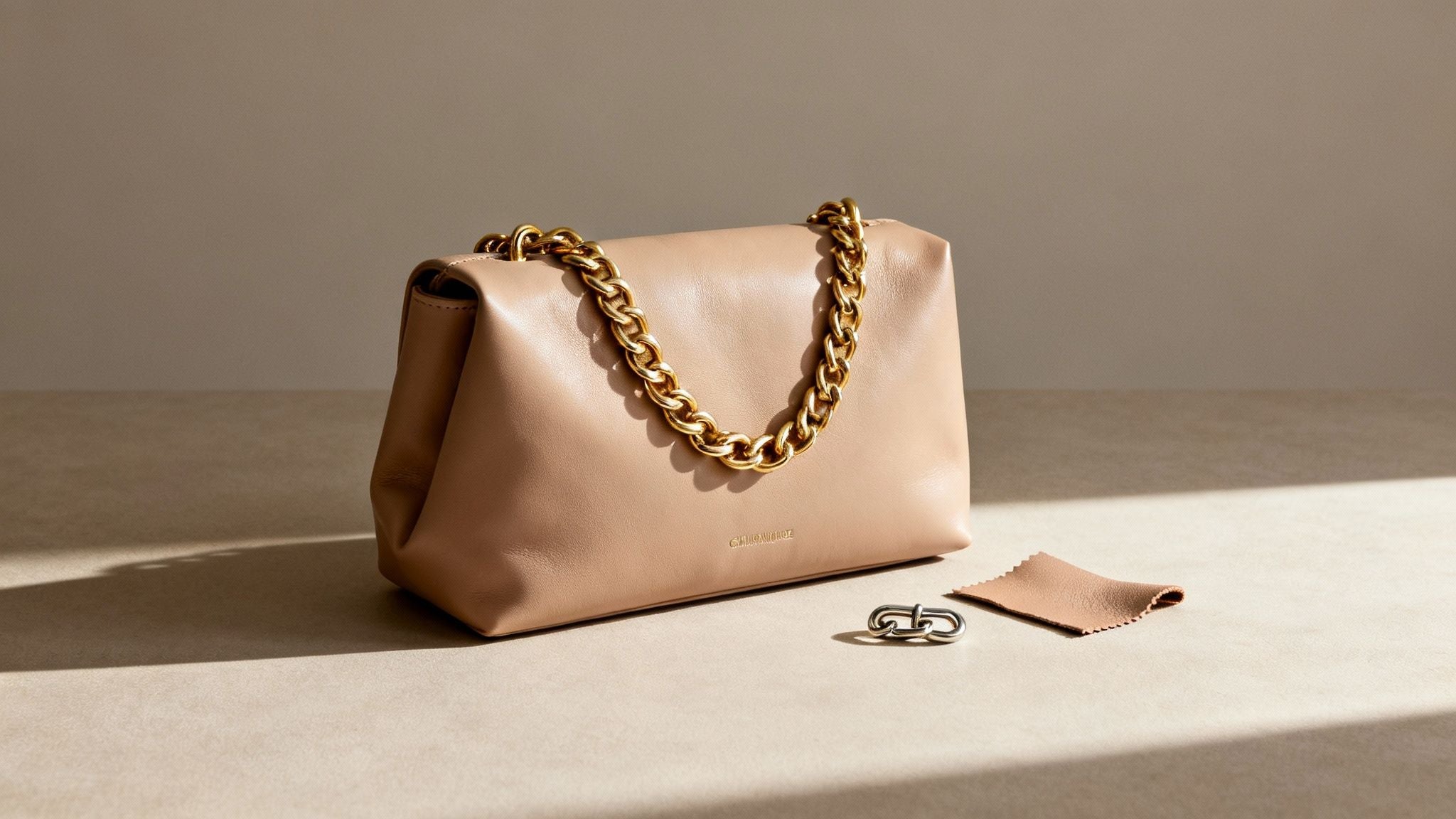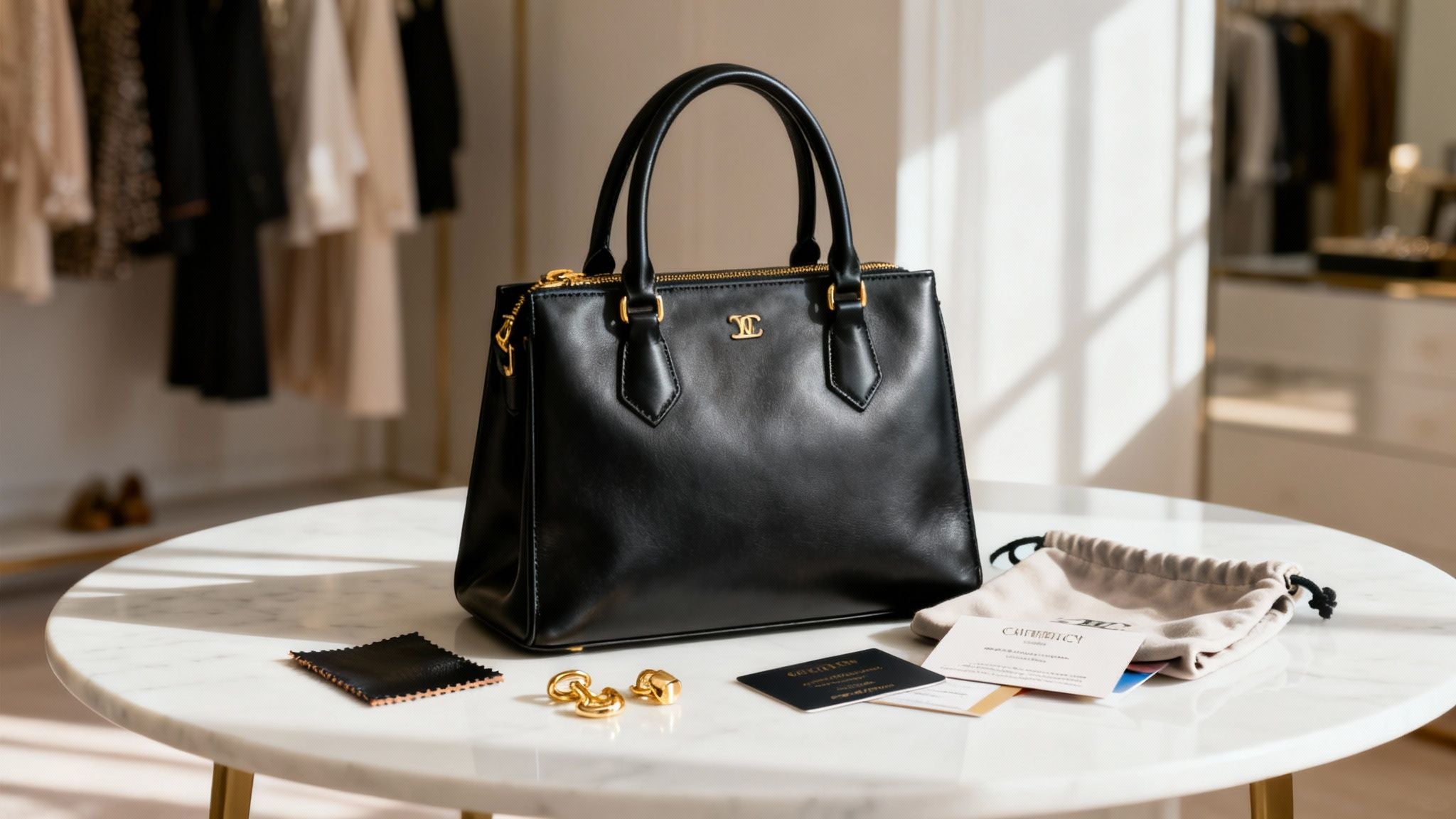A Guide to Designer Black Leather Bags
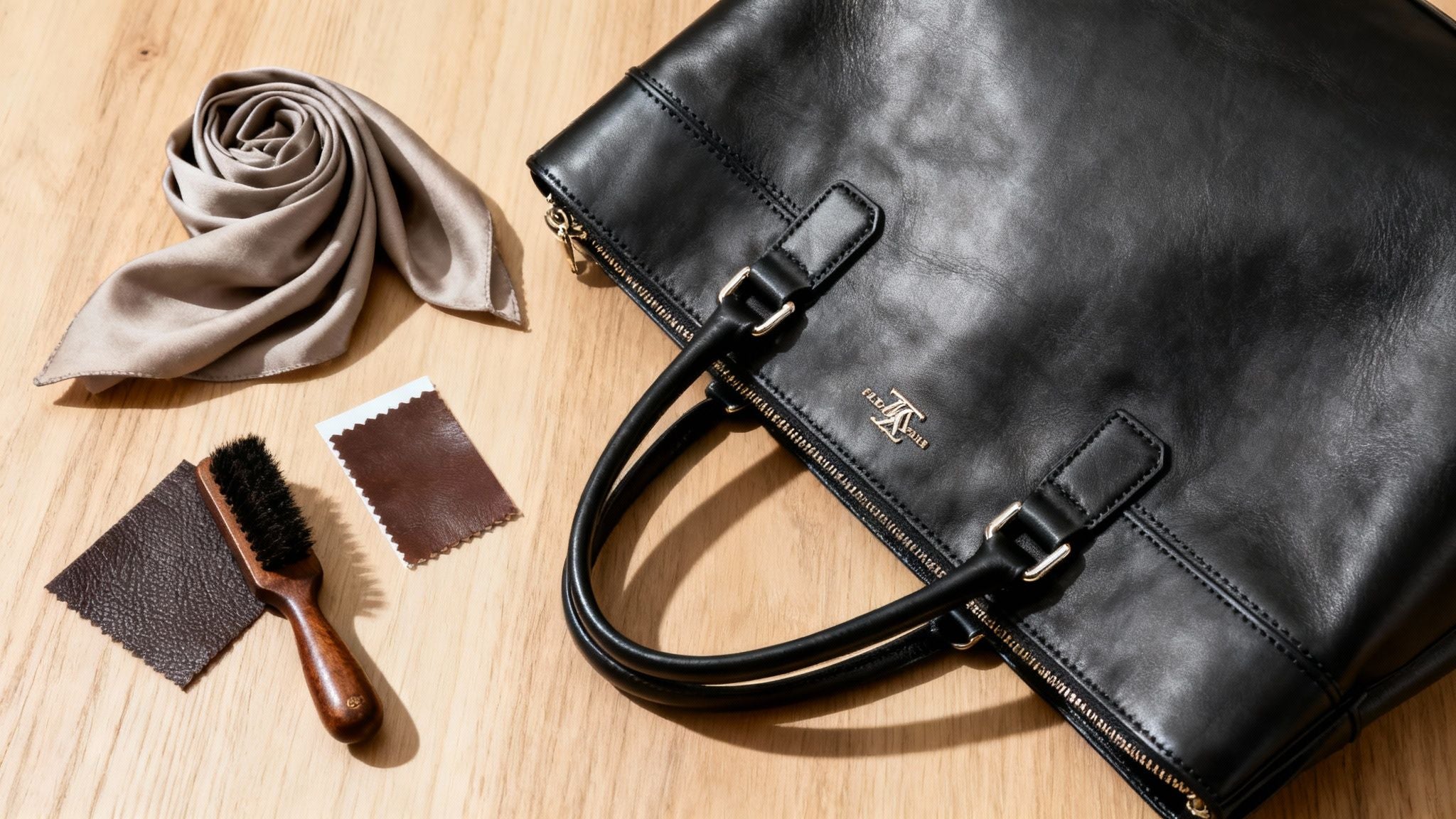
A designer black leather bag isn't just an accessory. It's so much more than that. Think of it as a cornerstone of your wardrobe—a single, beautiful piece that brings together luxury, versatility, and pure investment value. This one bag has the power to instantly elevate any outfit you can dream of, making it a true icon of sophistication and style.
Why a Designer Black Leather Bag Is an Essential Icon
A designer black leather bag is where fashion, function, and timeless appeal all meet. Unlike those trendy pieces that come and go with the seasons, a classic black bag is a constant. It's that reliable friend in your closet that speaks to a quiet confidence and incredible taste.
This is a bag that can truly do it all. It’s the ultimate chameleon, moving with you from a professional meeting at the office to a chic evening out without missing a beat. That versatility is its real superpower. It’s the foundational piece for all your other accessories, the one item you know will work with everything. Paired with a sharp suit, casual jeans, or an elegant dress, it always adds that perfect touch of polished refinement.
More Than Just an Accessory
When you invest in a high-quality black leather bag, you're making a decision that goes far beyond just how it looks. It's a smart, practical choice. These bags are crafted from incredibly durable materials meant to handle the rigors of daily life. In fact, they often get even better with age as they develop a rich, unique patina. The incredible craftsmanship ensures it will last, making it a piece you can carry for years—or even decades.
This longevity is what helps make them tangible assets. The global luxury handbag market was valued at an incredible USD 24.34 billion and is expected to soar to USD 43.9 billion by 2033. That’s a powerful testament to the sector's unstoppable growth. Many classic styles from the biggest brands hold their value beautifully, and some even become more valuable on the resale market. You can learn more about what's driving the luxury handbag market's expansion on Straits Research.
The true value of a designer black leather bag is its amazing ability to give you both everyday function and long-term worth. It’s a purchase that pays you back in style, confidence, and financial stability, making it one of the smartest additions you can make to your wardrobe.
Ultimately, choosing the right bag is a personal journey. It’s about understanding the different types of leather, knowing what quality construction looks like, and finding a shape that perfectly fits your lifestyle. To help you get started, our guide on selecting the best black designer handbag for your needs is the perfect place to begin.
Understanding Different Types of Leather
To really get what makes a designer black leather bag special, you have to start with its soul—the leather itself. "Leather" isn't just one thing; it's a huge spectrum of different textures, strengths, and finishes. Learning the difference is like understanding why a chef chooses a specific cut of steak; each one offers a unique experience.
Think of the leather as the very foundation of your bag. You wouldn't build a house on a weak base, and the same goes for a quality handbag. The type of leather a designer chooses dictates how the bag looks, how it feels in your hands, and, crucially, how it will age and tell its story over the years.
Knowing this language empowers you. It lets you see past a brand name and truly judge the quality of the piece you're investing in.
The Gold Standard: Full-Grain Leather
Right at the top of the leather world is full-grain leather. This is the best of the best, taken from the outermost layer of the hide. The key thing to know is that it hasn't been sanded or buffed to "correct" anything. That means it keeps all the natural markings, pores, and unique grain of the original hide.
These aren't flaws—they're proof of authenticity. Because the natural grain is left intact, full-grain leather is incredibly strong and durable. Over time, instead of wearing out, it develops a gorgeous patina. This is that rich, beautiful sheen that only comes with use, deepening the color and character. This is the leather that truly gets better with age.
The Practical Choice: Top-Grain Leather
Just a step below full-grain is top-grain leather. This is the second-highest quality and is actually the most common leather you'll find in high-end designer bags. For this type, the very top layer of the hide is given a light sanding to remove any imperfections, which creates a more uniform and sleek finish.
While this process does remove some of the hide's strongest fibers, top-grain is still exceptionally durable and high-quality. It's often treated with a protective coating, which makes it more resistant to stains and scuffs than full-grain. This makes it a fantastic, practical choice for an everyday bag that needs to look polished while standing up to daily life.
The infographic below really breaks down why a well-made designer black leather bag is such a wardrobe staple.
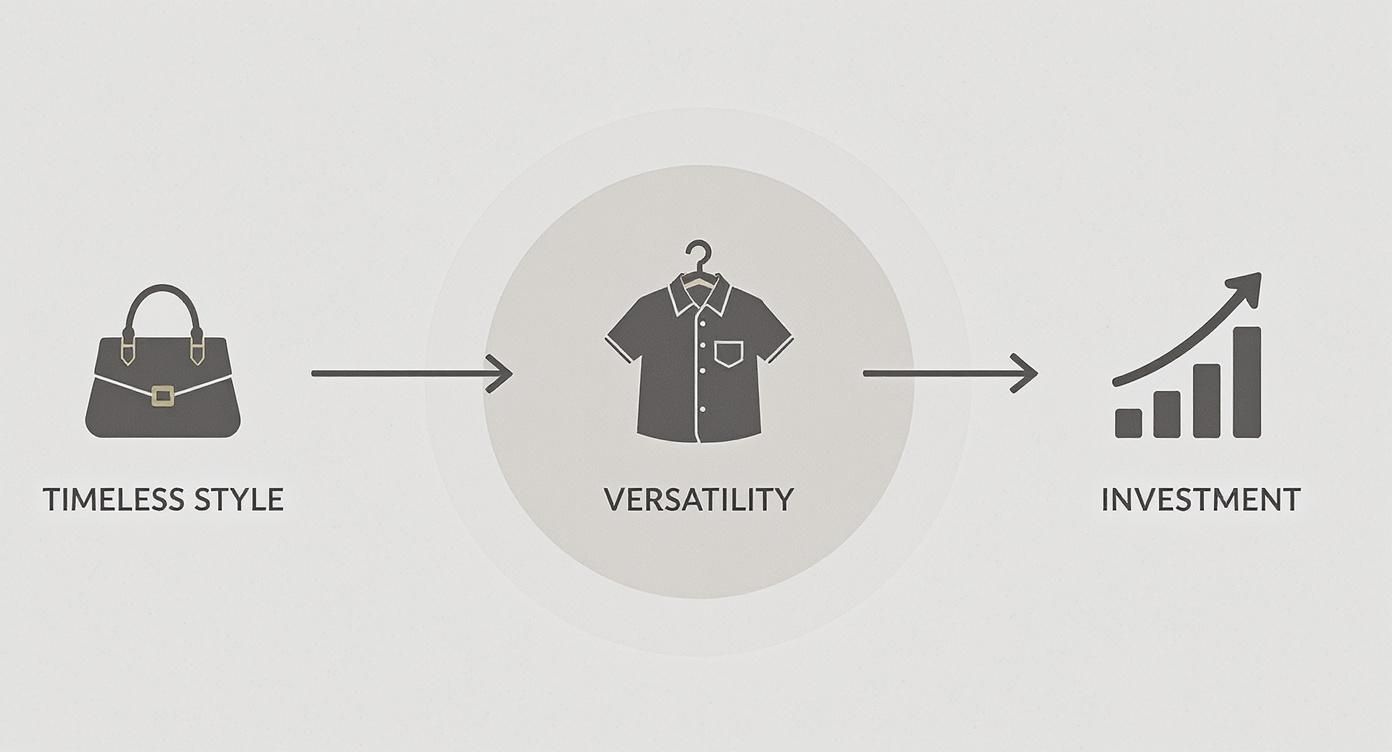
As you can see, it's a powerful mix of timeless style, go-with-anything versatility, and smart investment potential.
Corrected-Grain and Suede
As we move along the spectrum, you'll run into other common leathers, each with its own personality.
- Corrected-Grain Leather: This leather comes from hides that have more natural imperfections. The surface is sanded down significantly to create a blank slate, and then an artificial grain pattern is embossed onto it. While it looks less natural, it can be very durable and uniform, making it great for highly structured bags. For a deeper look into where the best leathers come from, you can learn more about what is Italian leather and its amazing reputation.
- Suede: Totally different from the others, suede is made from the soft underside of the hide. It's sanded to create that signature velvety, napped feel. It’s absolutely beautiful and soft to the touch, but it’s much more vulnerable to stains and water. A suede bag is a stunning statement piece, but it does ask for a bit more care.
Choosing the right leather really comes down to matching the material to your lifestyle. A full-grain tote is perfect for someone who loves a bag with rugged character that tells a story. On the other hand, a polished top-grain satchel might be the ideal partner for a daily commuter who needs a bag that's both durable and chic.
To help you quickly compare your options, here’s a simple breakdown of the most common leathers you’ll encounter when shopping for a designer bag.
Comparing Common Designer Bag Leathers
| Leather Type | Key Characteristics | Best For | Durability Level |
|---|---|---|---|
| Full-Grain | Natural grain, develops a patina, most durable. | Investment pieces, bags that get better with age. | Highest |
| Top-Grain | Smooth, uniform finish, stain-resistant. | Everyday use, work bags, polished look. | High |
| Corrected-Grain | Artificial grain, very uniform, budget-friendly. | Structured bags, durable and uniform appearance. | Moderate to High |
| Suede | Soft, velvety nap, delicate texture. | Occasion bags, statement pieces. | Low |
Understanding these materials elevates your shopping experience. It turns buying a bag from a simple purchase into a thoughtful choice, ensuring you find a piece you’ll love and carry for years to come.
How to Identify Quality Craftsmanship
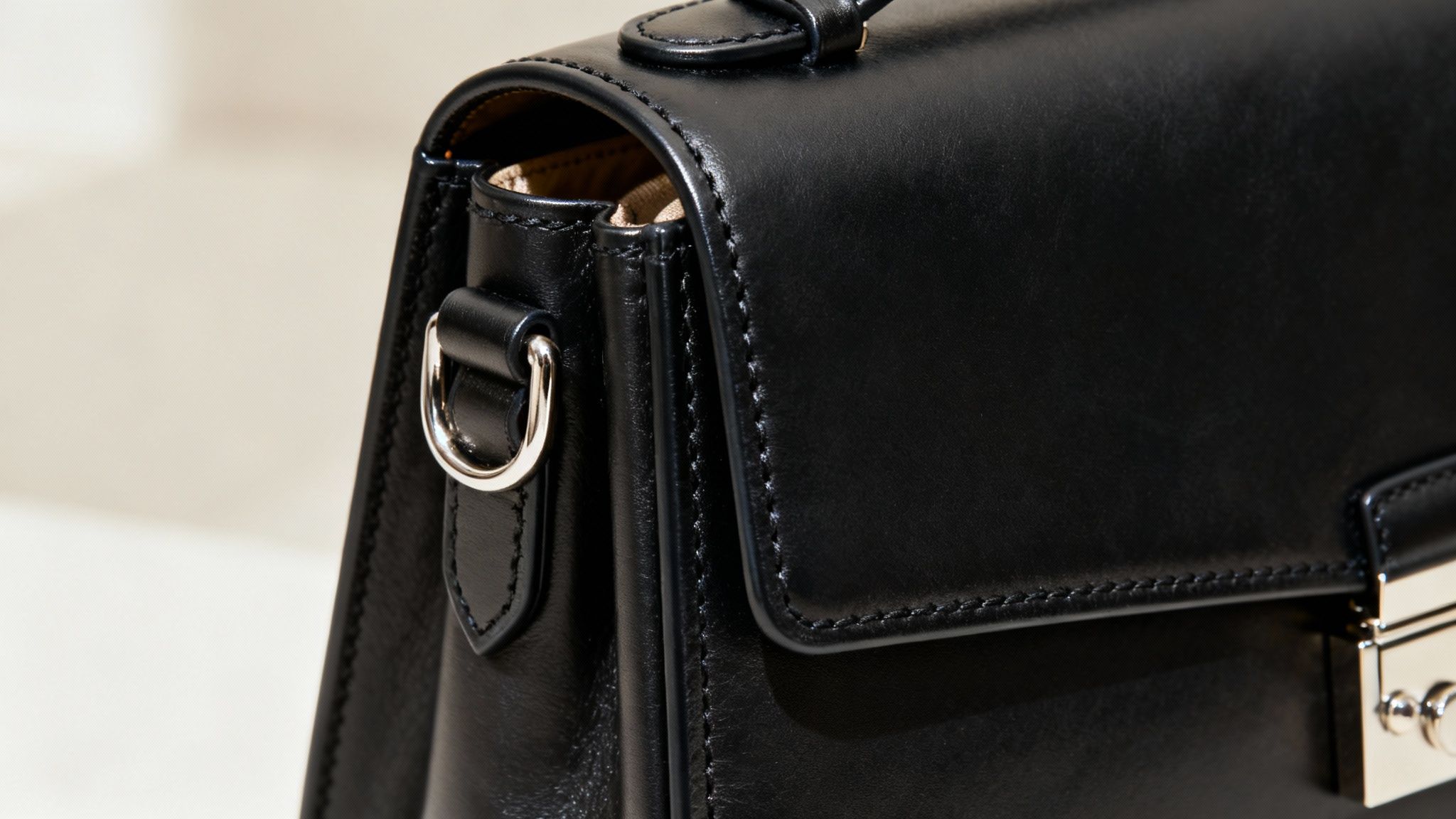
So, what really separates a good bag from a truly great one? It’s not just about the beautiful leather. The secret is in the hundreds of tiny details that scream high-end construction. Learning to spot these tells of quality craftsmanship turns you from a casual browser into a confident buyer, making sure your investment is one that will genuinely last.
It’s a lot like inspecting a finely tailored suit. You don't just feel the fabric; you look closely at the seams, the buttons, and the way the lining is set. The exact same rules apply to a designer black leather bag. These small elements are the language of quality, and once you know how to read them, you’ll be able to see the real value in any piece you pick up.
And this skill is more important now than ever. The global handbag market, valued at a staggering USD 56.48 billion, is set to climb to an incredible USD 81.79 billion by 2030. That kind of growth shows just how much people are coming to appreciate well-made, stylish accessories. You can find more details about the handbag market's expansion at Grand View Research.
The Stitching Tells a Story
The very first, and most obvious, sign of a well-made bag is its stitching. Think of it as the skeleton holding the entire piece together—and it needs to be perfect. Don't just give it a quick glance; get in there and really inspect it.
A high-quality bag will always have stitching that is perfectly straight, even, and consistent. Every single stitch should be the same length, with absolutely no loose threads, snags, or wobbly lines. Getting this right takes serious skill and specialized machinery, and it’s a true hallmark of luxury production.
On the flip side, messy or uneven stitching is a huge red flag. If you see stitches that are crooked, have funky tension (some tight, some loose), or look frayed, it’s a dead giveaway of rushed, low-quality manufacturing.
Feel the Weight of the Hardware
Hardware—we’re talking zippers, clasps, buckles, and feet—is another make-or-break element. It’s not just there to be functional; it’s a massive clue to the bag's overall quality.
Real designer hardware should feel solid and heavy in your hand. It's usually made from solid metals like brass or nickel, often with a smooth, polished finish that’s built to resist tarnishing. When you pull a zipper or snap a clasp, it should move like butter, with a satisfying click or pull.
A key takeaway is to always test the hardware. A zipper that catches, a clasp that feels flimsy, or metal that feels light and hollow are all signs that corners were cut. These small parts endure a lot of stress, and poor-quality hardware is often the first thing to fail on a poorly made bag.
Here are the key things to check for in quality hardware:
- Weight: Does it feel solid and substantial, or light and cheap?
- Finish: Is it smoothly polished with an even tone, or are there bubbles, pits, or signs of peeling?
- Function: Do zippers glide smoothly without snagging? Do clasps lock securely?
- Branding: If the hardware has a logo, is it crisp, clear, and perfectly centered?
Inspecting the Interior Lining and Edges
Believe it or not, the inside of a bag is just as important as the outside. A luxury brand invests in high-quality lining because they know true quality is about every single detail, whether it’s seen or not. The lining should be made from a durable material like high-grade cotton, microsuede, or even leather.
When you're looking at the lining, check that the seams are straight, tight, and totally finished. You shouldn't see any raw or frayed edges. The lining itself should fit perfectly inside the bag with no bunching or sagging—a sign of precision cutting and assembly.
Finally, take a close look at the edges of the leather, especially on the straps and flaps. On a top-tier bag, these edges are meticulously finished in a process called "edge painting," where they are sanded, painted, and polished. This gives them a smooth, durable, and clean line. In contrast, cheaply made bags often have raw, unfinished edges or a thin, sloppy layer of rubbery paint that will crack and peel in no time.
Finding Your Perfect Style and Silhouette
Picking out a designer black leather bag is more than just a purchase—it's about finding a true partner for your life. The right shape, or silhouette, isn't just a style statement. It’s a practical choice that needs to fit seamlessly into your day-to-day.
Think about it like this: a bag is a tool. You wouldn't use a hammer for a screw, right? The same logic applies here. The perfect bag for you depends entirely on what you need it to do. Are you a minimalist who just needs keys and a cardholder, or are you packing for a full day, from your laptop to a change of shoes?
Getting to know the most classic bag shapes is the first step to choosing one you’ll not only adore but actually use. It’s all about matching the bag's function to your personal rhythm, so you end up with something that feels like it was made just for you.
The Everyday Workhorse: The Tote Bag
When it comes to versatility and sheer carrying power, the tote bag is the undisputed champion. It’s known for its large, open-top design and two simple parallel handles, which make grabbing what you need an absolute breeze. If your life demands you carry a lot, the tote is your new best friend.
This is your mobile command center. It’s built to haul everything for a packed day: a laptop, notebook, water bottle, makeup bag, you name it. That makes it the ultimate choice for commuting, running errands, or those long days that turn into nights. Its relaxed, unstructured shape gives it a cool, effortless vibe that looks just as good with a power suit as it does with jeans and a tee.
Hands-Free Freedom: The Crossbody Bag
For those moments when you need to be agile and unburdened, the crossbody bag is the only way to go. You wear it over one shoulder so it rests on the opposite hip, giving you total hands-free convenience. Your essentials are secure and easy to reach, but completely out of your way.
The crossbody is a master of efficiency. It’s perfect for traveling, shopping trips, concerts, or anytime you need your hands free. While they’re smaller than totes, a well-designed crossbody still has plenty of room for your phone, wallet, keys, and other small necessities. Its security and ease of use make it a non-negotiable for anyone with an active, on-the-go lifestyle.
Choosing a silhouette is about being honest about your daily needs. The most beautiful bag is the one that doesn't just look good in your closet but feels right on your shoulder, effortlessly carrying the pieces of your life.
Structured Sophistication: The Satchel
The satchel strikes that perfect balance between the roomy feel of a tote and the polished look of a more structured bag. It usually has a flat bottom so it can stand on its own, a top handle for carrying, and often comes with a longer strap for wearing on the shoulder or as a crossbody.
This is the quintessential professional bag. Its structured form projects an image of polish and control, making it an ideal companion for the office or important meetings. Satchels also tend to have multiple compartments inside, which is fantastic for keeping everything organized. While you might be focused on accessories, don't forget that personal style extends to everything you carry, even things like black luggage with a distinct style.
Elegant Simplicity: The Clutch and Evening Bag
When the occasion calls for pure elegance, the clutch is the answer. Small, strapless, and made to be held in your hand, a clutch is the very definition of evening chic. It forces you to pare down to just the absolute essentials—your phone, a lipstick, a credit card, and a key.
That minimalist design is its greatest strength. A black leather clutch is a timeless statement piece that’s perfect for formal events, weddings, or a sophisticated night out. It complements your outfit without overwhelming it, proving that sometimes the most powerful accessories are the ones that carry the least.
Essential Care for Your Leather Investment
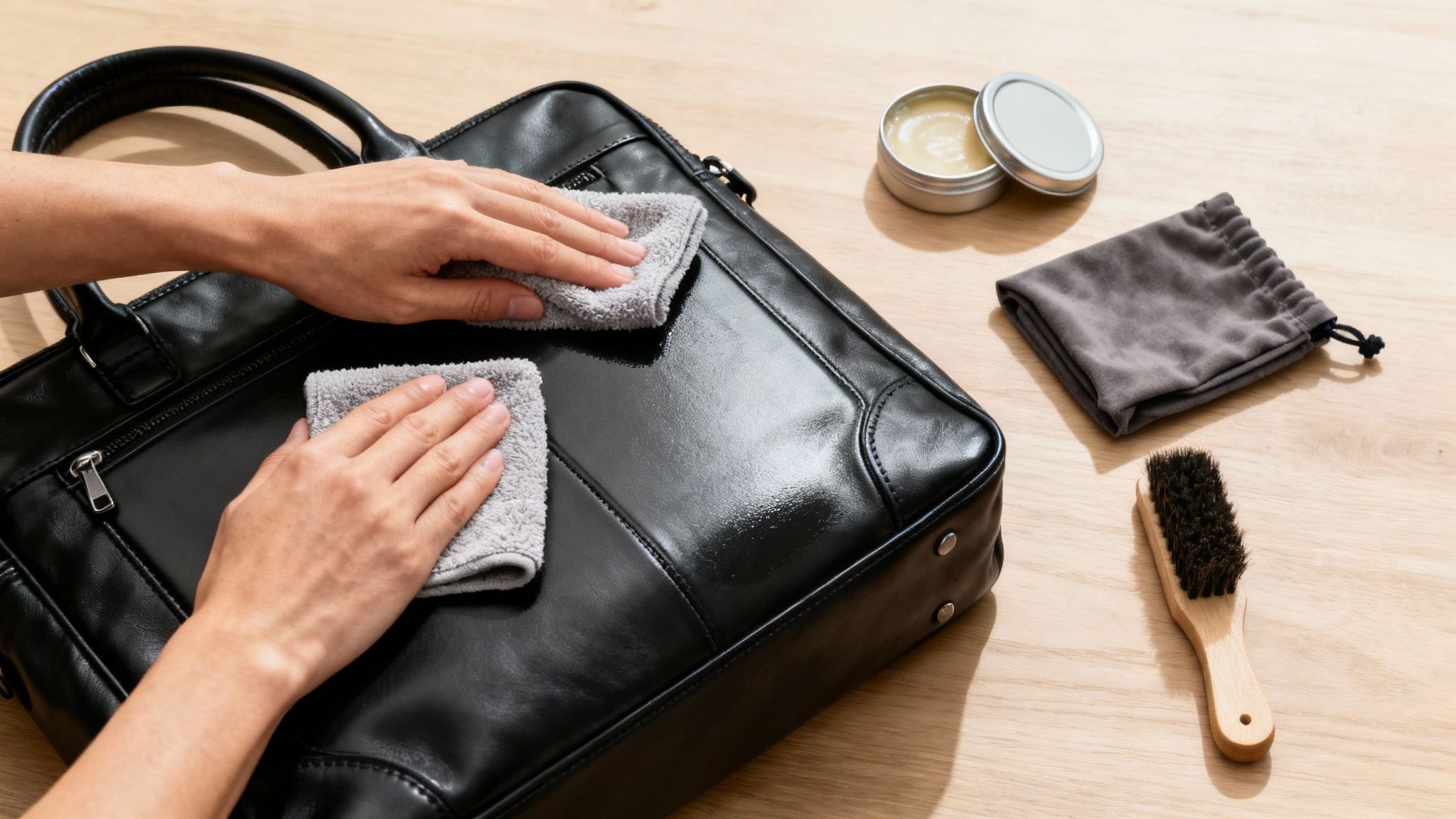
A designer black leather bag isn’t just another accessory—it’s an investment in your personal style, one that’s meant to last. But just like any valuable piece, it needs a little TLC to keep it looking its best. The good news? Proper care doesn't have to be a chore. A few simple, consistent habits are all it takes to protect your bag from wear and tear, ensuring it remains a staple in your collection for years, or even decades, to come.
It helps to think of leather as skin, because that's essentially what it is. It needs to be cleaned gently and moisturized from time to time to stay soft and supple. Skipping this care can lead to dryness, cracking, and a dull finish that prematurely ages your beautiful bag. A simple routine is the secret to preserving that luxurious look and feel.
Routine Cleaning and Conditioning
First things first: regular, gentle cleaning. Dust, natural oils from your hands, and everyday grime can build up on the surface. For the most part, a quick wipe-down with a soft, dry microfiber cloth once a week is all you need to keep it looking fresh.
If you need a slightly deeper clean, you can lightly dampen the cloth with water—but never soak the leather. Gently wipe the surface in small circles, then let the bag air dry completely. Be sure to keep it away from direct heat or sunlight, as this can cause the leather to warp or even crack.
Next up is conditioning, which is absolutely crucial. A good leather conditioner is like a moisturizer, restoring the natural oils in the hide that keep it flexible and prevent it from drying out.
- Frequency: Plan to condition your bag every 3-6 months. If you live in a particularly dry climate or use the bag daily, you might need to do it a bit more often.
- Application: Put a small, dime-sized amount of conditioner onto a clean cloth. Rub it into the leather gently using circular motions, making sure you get even coverage across the entire surface.
- Finishing: Let the conditioner soak in for about 30 minutes. Afterwards, take a fresh, dry cloth and buff away any excess product.
Always, always do a spot test before using a new cleaner or conditioner. Pick a hidden spot—like the bottom of the bag or an interior leather tag—and apply a tiny amount to make sure it doesn’t cause any discoloration.
Proper Storage Is Non-Negotiable
How you store your bag when it’s not in use is just as important as how you clean it. Tossing it in the closet can lead to ugly creases, loss of shape, and other damage. The goal is to help your bag keep its original, structured silhouette.
To do this, lightly stuff the bag with acid-free tissue paper or even a soft scarf. This simple trick prevents it from collapsing on itself and developing permanent wrinkles. Just be sure to avoid using newspaper, as the ink can easily transfer to the bag's lining.
Finally, always place your bag inside its original dust bag before putting it away. This little cover is its best line of defense against dust, accidental scratches, and color fading from ambient light. Store it upright on a shelf in a cool, dark place with good air circulation. Never hang your bag by its straps for long periods, as this will inevitably cause stretching and put stress on the handles.
For a more detailed breakdown of these techniques, check out our comprehensive guide on how to care for leather bags. Following these steps will protect your investment and ensure your bag is always ready for its next outing.
The Future of Designer Leather Bags
The world of luxury never stands still, and the classic black leather bag is evolving right alongside it. The timeless silhouettes we all know and love are being reimagined through the lens of modern values and incredible new possibilities.
This isn’t about replacing what works; it’s about enhancing it. We're talking about a deeper commitment to sustainability, smarter technology, and a whole new way of thinking about ownership. It’s an exciting time where heritage craftsmanship is finally meeting forward-thinking ideas. This whole shift is really being driven by a new kind of luxury shopper—someone who cares just as much about transparency and innovation as they do about the brand name on the tag.
The Rise of Sustainable Luxury
Sustainability has officially gone from a niche interest to a powerful force reshaping the entire industry. Today's buyers are demanding that their favorite brands get serious about ethical and environmentally friendly practices. This has sparked a huge wave of creativity, pushing designers to explore materials and methods that are both beautiful and responsible.
This movement is happening on a few different fronts:
- Innovative Vegan Leathers: Forget the stiff, plastic-y "pleather" of the past. Brands are now creating stunning, high-end vegan leathers from plant-based sources like mushrooms, apples, and even cacti. These materials are engineered to give you that same luxurious feel and durability of traditional leather, but without the environmental baggage.
- Ethical Sourcing: There's a huge new focus on knowing exactly where materials come from. Luxury houses are investing heavily in supply chains that can guarantee animal welfare and use tanning processes that slash water usage and eliminate harmful chemicals.
- Upcycling and Circular Design: Designers are getting incredibly creative with giving old materials a second act. They’re crafting brand new bags from reclaimed leather or incorporating recycled components into fresh designs.
The new definition of a luxury designer black leather bag isn't just about its look and feel. It’s about the story of how it was made. It's about feeling good about your purchase, from start to finish.
Smart Technology and Personalization
Technology is weaving its way into the very fabric of luxury, offering new layers of security and customization that were once unthinkable. The current market for designer black leather bags reflects these changes, with a booming interest in sustainable alternatives and integrated smart tech. The resale market has also exploded, which you can read more about in this classic leather handbag market analysis on ShelfTrend.
One of the coolest advancements is digital authentication. Brands are starting to embed tiny microchips or unique digital IDs right into their bags. This lets you verify that your bag is the real deal with a simple scan of your smartphone. It’s a game-changer for providing peace of mind and fighting back against the counterfeit market.
On top of that, AI-powered tools are opening up amazing new possibilities for personalization, allowing you to co-design parts of your bag for a piece that is truly, uniquely yours.
A Few Final Questions
Diving into the world of designer black leather bags can feel like a big step, especially when you're making a real investment. We've gathered some of the most common questions to help you feel confident and excited about your choice.
Are Designer Black Leather Bags a Good Investment?
Absolutely. The right bag isn't just an accessory; it's an asset. Iconic styles from the big-name fashion houses often hold their value incredibly well, and some even appreciate over time, especially if you keep them in beautiful condition.
Their timeless appeal and the incredible craftsmanship behind them mean they're built to be loved for decades, not just a single season. Plus, with the booming pre-owned luxury market, a classic black leather bag has truly cemented its status as a tangible investment.
How Can I Tell if a Designer Leather Bag Is Fake?
Spotting a fake often comes down to the little details. The counterfeit market is getting better, but they almost always slip up on the small things that define true luxury.
Keep an eye out for these key areas:
- The Feel of the Leather: Real, high-quality leather has a specific texture and often a subtle, rich scent. Fakes can feel stiff, plasticky, or have a strange chemical smell.
- Stitching: This is a big one. Authentic bags have perfect, even, and tight stitching. Any loose threads, crooked lines, or sloppy work is an immediate red flag.
- Hardware: Genuine hardware feels heavy and substantial. Zippers should glide like butter, and clasps should snap shut securely with a satisfying click.
- Logos and Branding: Look closely at the font, spacing, and clarity of any logos or brand stamps. Counterfeits often have slight misspellings or sloppy, blurred lettering.
When in doubt, always play it safe. Buy from an authorized retailer or, for a pre-owned piece, consider using a professional authentication service.
A genuine designer bag is a sum of its parts. True quality is consistent, from the largest panel of leather down to the tiniest stitch. If any single element feels cheap or poorly executed, it’s a strong indicator that the bag may not be authentic.
What Is the Most Durable Type of Leather for a Handbag?
When it comes to pure, rugged durability, full-grain leather is the undisputed champion. This is the top layer of the hide, the strongest part, and it hasn't been sanded down. It retains all of its natural strength and character, developing a gorgeous, unique patina as it ages instead of wearing out.
For everyday bags that need to stand up to a lot, pebbled and Saffiano leathers are also fantastic choices. Their textured surfaces and protective finishes make them incredibly resistant to scratches, scuffs, and even a bit of rain.
At The Bag Icon, we believe that owning a beautiful, high-quality leather handbag shouldn't be out of reach. Discover our collection of affordable luxury and find your perfect style today at https://www.thebagicon.com.
